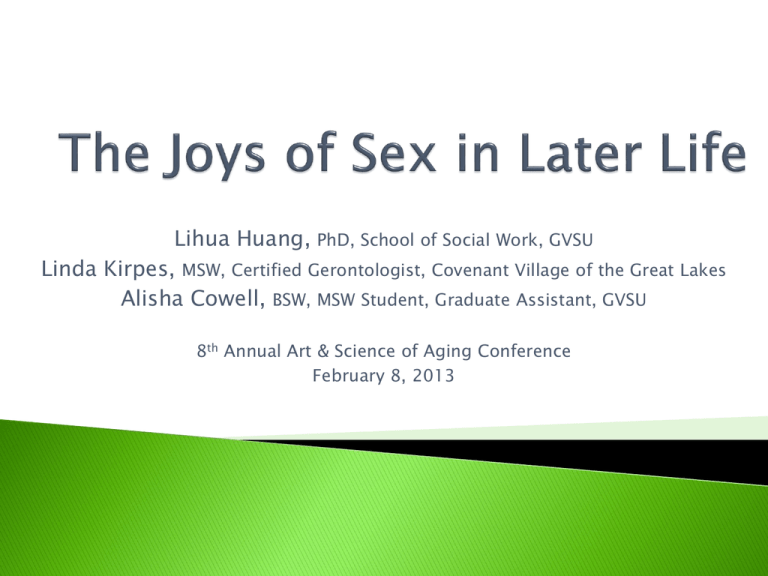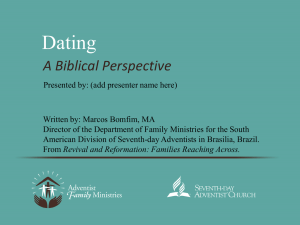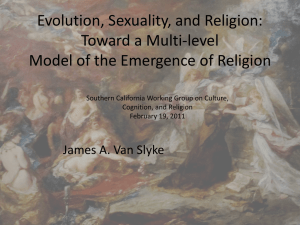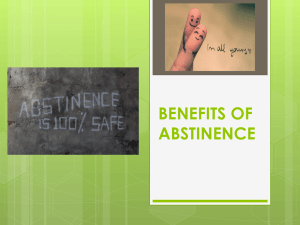
Lihua Huang, PhD, School of Social Work, GVSU
Linda Kirpes, MSW, Certified Gerontologist, Covenant Village of the Great Lakes
Alisha Cowell, BSW, MSW Student, Graduate Assistant, GVSU
8th Annual Art & Science of Aging Conference
February 8, 2013
Sexual activity in aged persons is often dangerous to their health (F)
Sexuality is typically a lifelong need (T)
The sex urge typically increases with age in males over 65 (F)
There is a decrease in frequency of sexual activity with older age in males (T)
Prescription drugs may alter a person's sex drive (T)
Sexual behavior in older people (65+) increases the risk of heart attack (F)
Most older females are sexually unresponsive (F)
The firmness of erection in aged males is often less that that of younger persons (T)
There is evidence that sexual activity in older persons has beneficial physical effects on
the participants (T)
There is a greater decrease in male sexuality with age than there is in female sexuality
(T)
Fear of the inability to perform sexually may bring about an inability to perform sexually
in older males (T)
There is an inevitable loss of sexual satisfaction in post-menopausal women (F)
In the absence of severe physical disability males and females may maintain sexual
interest and activity well into their 80s and 90s (T)
Sexuality is an integral part of the personhood of
every human being in all societies.
Sexual rights are human rights related to sexuality;
Sexual rights are universal, interrelated,
interdependent and indivisible;
Sexual rights’ protection and promotion should be
part of the daily existence of all individuals;
Sexuality should be recognized as a positive aspect
of life
International organizations have recognized and
demanded sexual rights as universal rights based
on inherent freedom, dignity and equality of all
human beings (WHO, 2000; IPPF, 2006);
Older adults shall have rights to:
Access the highest attainable standard of sexual
health;
The absence of sexually transmitted disease;
Access to sexual education, and
Decisions to be sexually active or not
Where does the sexual rights movement come
from?
Population aging?
The rise in incidence of STIs/HIV among older
adults?
Pharmaceutical conspiracy in marketing drugs for
sexual dysfunction?
Pangman and Seguire (2000) made sexual rights a
social justice issue by recognizing how society and
long-term care facilities have been denying older
adults’ sexual expression and excluding them
from meaningful relationships and intimacy.
Gerontology and research have echoed above
demands for sexual rights in later life since
late 1990s.
Gerontologists have described sexuality
central to sense of self, self-esteem, and
body image in later life (Johnson, 1996;
Moore, 2010).
Sexuality makes individuals who they are,
including biological, psychological, social,
cultural, and spiritual aspects of self
(Johnson, 1996);
Moore conducted a life history interview
study in Japan in 2004-2008. The results
from the large set of interview material
indicate gender, culture, and other
environmental characters.
1.
2.
3.
Men were more accustomed to speaking about
their sexual experiences and embodying an active
sexuality as part of their identity;
Women were generally much more reserved in
their commentaries about sexual relations;
Differ from previous assumptions about Japanese
men’s sexuality in later life, male participants
convicted that sexual desire continues to be an
important barometer of wellbeing in later life
even if it is not channeled into sexual acts.
Society helps to impose barriers which results in
the sexuality of older adults being devalued
(DeLamater, 2012).
Older adults are often not seen as sexual beings
which matriculates into interactions between
caregivers and residents (Rheaume & Mitty, 2008).
The inaccurate views people have in regards to
older adults and sexuality negatively affects the
professional relationships older adults have with
their physicians and care givers.
Many healthcare providers do not ask questions
about sexual health during examinations with their
patients (Farrell & Belza, 2012).
Some of the reasons stated:
Lack of adequate training in school
Not enough time to discuss sexual health
Not wanting to offend or embarrass their
patients (Farrell & Belza, 2012).
Rooted in perceptions of body image, beliefs and
values dealing with sexual expression and lack of
knowledge or comfort with sexuality (Rheaume &
Mitty, 2008).
Loss of partner through death or incapacity.
Relationships status is a major influence on
whether or not a person engages in partnered
activity (DeLamater, 2012).
Lack of privacy in communal living environments of
assisted living or nursing homes.
Older adults lack accurate information about
sexuality.
Sex education was not part of standard curriculum
during the formative or college years of today’s
older adults (Rheaume & Mitty, 2008).
As a result, there has been rising rates of HIV/AIDS
in older adults.
Diagnosis tends to be made later and the disease
course is faster.
Often perceived as low risk for HIV/AIDS and are
not targeted as high risk population for HIV by
public health agencies.
Sexual assault is often perceived as an act only
against younger people.
For example, older women are also victims of
sexual assault regardless of the setting: domestic,
institutional, or homeless (Baker, Sugar & Eckert,
2009).
“Acute and long-term stress associated with
victimization contributes to negative health
outcomes (Baker, Sugar &Eckert, 2009)”
The majority of older adults are engaged in spousal
or other intimate relationships and consider
sexuality as an important part of life (Lindau,
Schumm, Lauman, Levinson, O’Muircheartaigh &
Waite 2007).
“Sexuality has been described as an important
component of health and as an integral part of
self-expression (Robinson & Molzahn, 2007).”
Regular (consensual) sexual expression contributes
to physical & psychological well-being (DeLamater,
2012).
Consistent sexual expression has been found to
reduce physical and mental health problems
associated with aging (DeLamater, 2012).
Studies also report that engaging in penile-vaginal
intercourse is correlated with higher quality of
intimate relationships, low rates of depressive
symptoms and improved cardiovascular health
(DeLamater, 2012).
http://www.dailymotion.com/video/xspfg_lib
ido-old-people-sexuality-sexe-er_sexy
Recognize and demand sexual rights of all
older adults;
“Too often denied and too long neglected,
sexual rights deserve our attention and
priority. It is time to respect them. It is time
to demand them.” (Jacqueline Sharpe,
President of IPPF, WHO)
Understand the underlying social, cultural and
economic factors that make individual older adults
vulnerable to risks of discrimination, prejudice,
STIs and HIV, and lack of sexual education.
Establish a legal policy and regulatory environment
where the sexual rights of all people are upheld;
Build a functioning referral system that have
preventive measures and treatments;
Train sexual health providers;
Listen and understand needs for love, sex and
intimacy in later life.
Physical and mental health is important to sexual
expression
Older women and men in good health are more likely to be
sexually active than those in fair to poor health (Lindau &
Gavrilova, 2010);
There is a strong, positive association between the rating of
one’s health and repors of engaging in sexual intercourse
at least once per week (AARP, 2010);
Women and men in excellent or good health are estimated
to gain 3-7 additional years of sexual activity compared to
women and men in fair or poor health (Lindau & Gavrilova,
2010);
Lindau and Gavrilova created “Sexually active life
expectancy,” which calculates “the average number
of years remaining spent as sexually active” (2010,
p.3):
According to their calculation, at age 55, the
estimated sexually active life expectancy is 15
years for men and 10.6 years for women;
The expectancy for people with a partner is very
similar for men and women.
There is little evidence that normal physical changes
associated with aging necessarily or irreversibly impact sexual
functioning in women and in men:
Women may experience vaginal dryness and atrophy, as a
result of gradual decline in levels of estrogen in the body;
The studies on effects of menopause on sexual functioning
suggest it contributes to meaning women attribute to
menopause rather than menopause itself;
Men may experience slower erections, less firm erections,
decreased likelihood of orgasms, and longer refractory
periods as a result of a slow decline in testosterone
production;
Sexual desire/interest can be measured by
1.
Frequency of sexual thoughts.
2.
Frequency of enjoyment of sex, and
3.
Sexual arousal.
Literature on sexual functioning presumes, implicitly or
explicitly, that sexual desire is important;
Frequency of desire predicted frequency of sexual intercourse
(Kontula & Haavio-Mannila, 2009);
Sexual desire is significantly associated with reported frequency
of sexual touch and sexual intercourse for both men and
women;
Desire is associated with frequency of masturbation (DeLamater
& Moorman, 2007).
It is evident that diabetes is associated with reduced female
sexual activity and increased erectile difficulties among males
(Lindau et al.,2007: Moreira et al., 2008);
Less frequent masturbation by both men and women;
Pain during intercourse are associated with diabetes in men
and arthritis in women;
Lack of pleasure associated with reports of hypertension
among men;
Diabetes and hypertension are associated with sexual
dysfunctions among older men and women (Lindau et al.,
2007).
However, the evidence does not support that medical
illnesses are a major influence on declining sexual desire and
behavior or increasing sexual distress and dysfunction in later
life.
Research has suggested that sexual
functioning and sexual health are influenced
greatly by psychosocial factors rather than
physical changes associated with aging
(AARP, 1999; DeLamater, 2012; DeLamater &
Moorman, 2007).
A sensitive subject
Establish trust first
Begin with easy topics
Ask open-ended questions
Integrate midway into health assessment
Never assume heterosexuality
Sexual education materials
Be an ongoing resource
Can you tell me how you express your sexuality?
What concerns or questions do you have about
fulfilling your continuing sexual needs?
In what ways has your sexual relationship with your
partner changed?
What information or interventions can I provide to
help you fulfill your sexuality?
______1.
______2.
______3.
______4.
______5.
______6.
______7.
______8.
Are you currently sexually active?
Are you currently sexually active with more than one partner?
What kinds of protection do you and your partner use during
sexual activity?
How has your illness and/or medication affected your sexual
activity?
Do you have questions or concerns about your sexual activity?
Have you ever had a sexually transmitted disease, or
knowingly been exposed to somebody with a sexually
transmitted disease?
Have you ever had, or do you now have, discharge, rashes, or
sores in the genital area?
Is there anything you would like to discuss concerning sexual
issues?
Source: Levtak, S., & Schoder, D. (1996). Sexually transmitted diseases in the elderly: What you need to
know. Geriatric Nursing,
17(4), 156-160.
http://www.dailymotion.com/video/xspfg_lib
ido-old-people-sexuality-sexe-er_sexy
Baker, M. W., Sugar, N. F., & Eckert, L. O. (2009). Sexual assault of older women: Risk and vulnerablity
by living arrangement. Sexuality Research & Social Policy, 6(4), 79-85.
DeLamater, J. (2012). Sexual expression in later life: A review and synthesis. Journal of Sex Research, 49(1/2),
125-141.
Farrell, J., & Belza, B. (2012). Are older patients comfortable discussing sexual health with nurses?.
Research, 61(1), 51-57.
Nursing
Giami, A. (2002). Sexual health: The emergence, development, and diversity of a concept. Annual
Sex Research, 13(2), 1- 35.
Review of
Gott, M., & Hinchliff, S. (2003). How important is sex in later life? The views of older people. Social
Medicine, 56, 1617-1628.
Science &
Gott, M., Hinchliff, S., & Galena, E. (2004). General practitioner attitudes to discussing sexual health
with older people. Social Science & Medicine, 58, 2093-2103.
issues
Hinchliff, S., & Gott, M. (2008). Challenging social myths and stereotypes of women and aging:
Heterosexual women talk about sex. Journal of Women & Aging, 20(1/2), 65-81.
Hordern, A. J., & Street, A. F. (2007). Constructions of sexuality and intimacy after cancer: Patient and health
professional perspectives. Social Science & Medicine, 64, 1704-1718.
Lindau, S. T., Laumann, E. O., O, C. A., Waite, L. J., & Waite, L. J. (2007). A study of sexuality and health
among older adults in the united states. New England Journal of Medicine, 357(8), 762-774.
Minichiello, V., Hawkes, G., Pitts, M. (2011). HIV, sexual transmitted infections, and sexuality in later life.
Current Infectious Disease Reports, 13(2), 182-187.
Potts, A., Gavey, N., Grace, V. M., Vares, T. (2003). The downside of Viagra: Women’s experiences and
concerns. Sociology of Health & Illness, 25(7), 697-719.
Rheaume, C., & Mitty, E. (2008). Sexuality and intimacy in older adults. Assisted Living in Nursing
29(5), 342-349.
Practice,
Robinson, J. G., & Molzahn, A. E. (2007). Sexuality and quality of life. Journal of Gerontological Nursing,
33(3), 19-27.
Skultety, K. M. (2007). Addressing issues of sexuality with older couples. Generations, 31(3), 31-37.
Smith, K. P., & Christakis, N. A. (2009). Association between widowhood and risk of diagnosis with a sexually
transmitted infection in older adults. American Journal of Public Health, 99(11), 2055- 2062.
World Health Organization. (2006). Defining sexual health: Report of a technical consultation on sexual
health. Geneva: WHO.








